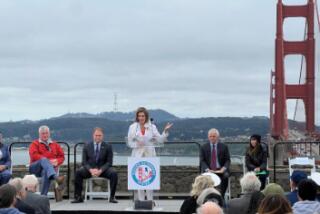Suicide watch
- Share via
IN THE DOCUMENTARY film “The Bridge,” which opened last month, six people are seen jumping to their deaths from the Golden Gate Bridge. Inspired by a 2003 New Yorker magazine article that explored the bridge’s status as the world’s most popular suicide destination (on average, someone jumps every two weeks), director Eric Steel and his crew filmed the bridge almost every daylight minute of 2004. The result is an honest, well-crafted piece of work that some people are saying should never have been made. They’re mistaken.
Steel says he “wanted to make a film about the human spirit in crisis, that showed but did not judge.” There is no judgment in the film. But is it showing too much? Juxtaposed with suicide footage are astonishingly beautiful scenes of the bridge and astonishingly candid interviews with victims’ families and friends; the film asks more questions than it answers.
Most fundamentally, it asks how much we can ever really understand about suicide. Despite their anger and devastation, friends and family members interviewed convey a sense of relief that is both utterly human and more shocking than the footage of those who leapt to their deaths.
It’s not uncommon for thwarted jumpers to return to the scene multiple times before making the final leap. The film captures one woman who is pulled back over the railing by a man taking photographs; we later learn that this was not her first attempt. The question is also posed as to whether suicides of this nature are inevitable.
That has been part of the long-running debate about whether to build a suicide barrier along the bridge, a project that would cost an estimated $25 million. Some opponents say it would needlessly compromise aesthetics for the sake of people who are determined to kill themselves anyway.
For his part, Steel says he was in frequent contact with members of the Golden Gate Bridge Patrol during the filming and tried to intervene whenever possible. Although the film steers clear of the debate about building a suicide barrier, Steel advocates a barrier, noting that the Golden Gate Bridge District’s security cameras, bike patrols and hotline phones have not affected the rate of suicides.
Such issues aside, some viewers of “The Bridge” may question the ethics of the film, even as they marvel at its skillfulness and restraint. Despite the shock element, the film is an important document about a landmark whose near-mythic beauty has always borne the burden of unspeakable tragedy.
More to Read
Sign up for Essential California
The most important California stories and recommendations in your inbox every morning.
You may occasionally receive promotional content from the Los Angeles Times.













